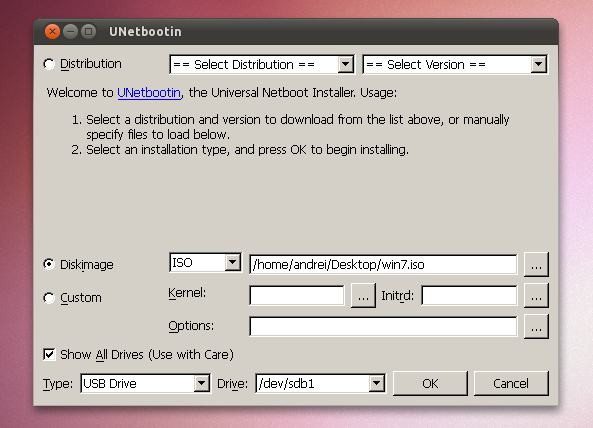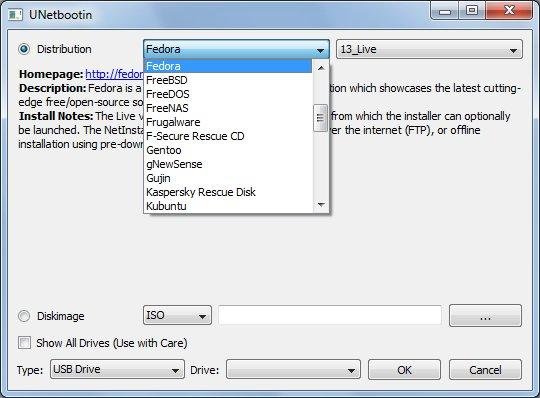

- #Unetbootin usb installer install
- #Unetbootin usb installer software
- #Unetbootin usb installer windows
Unetbootin then finishes the transaction with a message and presents the buttons Reboot now and Finish.
#Unetbootin usb installer software
If everything goes as expected, the software will download an ISO from an FTP server, unpack the ISO, copy it to the stick, and generate a matching configuration file for the Syslinux bootloader.
#Unetbootin usb installer install
Pressing OK launches Unetbootin – sink or swim time ( Figure 2).įigure 2: If you select a distribution the software supports, Unetbootin will retrieve it from an FTP server and install the distribution on your memory stick. If you choose Show all drives, Unetbootin will list other drives – this is useful if you are not sure you have found your USB stick. At the bottom, select USB drive as the Type, and select the newly created sdb1 partition from the drop-down menu to the right. The small text box below this tells you something about your choice of distribution. In the Distribution pull-down menu select your favorite distribution and the matching version number on the right ( Figure 1). With the empty, mounted stick prepared, it is now time to launch Unetbootin.

In the file manager, you should now see a Lost+Found folder – but nothing else. The drawback to this option is that FAT32 does not support files of more than 4GB.Īfter completing the format, unplug the stick, plug it back in to the USB port, and make sure the system mounts it again.
#Unetbootin usb installer windows
If you want to store Windows files on the stick, you need to run the mkfs.vfat -F 32 /dev/sdb1 command to create a FAT32 partition. Linux writes blocks of 4KB (as defined by the -b 4096 option) to speed up the process. Linux will now write a fresh filesystem to the stick this can take a couple of minutes. To do so, become root and type mkfs.ext3 -b 4096 /dev/sdb1, again replacing sdb with the device file for your USB stick. The next step is to format the empty – and still unmounted – partition with the ext3 filesystem. Fdisk now writes all the changes to the stick you can cancel at any time before this. Pressing A and -1 enables the partition you created by setting the boot flag now finish the preparation work by pressing W (for "write"). To use the first partition, select -1 then press Enter twice to use all the sectors on the stick. After deleting the partitions, press N to create a new partition it needs to be a primary partition ( P). If the stick only contains one partition, you do not need to specify a number. Then press D and type the partition number to delete the partitions. Type P to discover how many partitions are on the stick. Now, working as root, type fdisk /dev/sdb to launch the Fdisk partitioning tool the tool is controlled from the keyboard. The sdb: sdb1 line tells you that your system has assigned a device file of /dev/sdb to the stick, which has a partition called /dev/sdb1. To discover the mount point ID, launch a terminal and type tail -f /var/log/messages shortly before unplugging the stick. To start, type sudo umount /dev/sdb1 to mount the stick, replacing /dev/sdb1 used in this example with the correct mount point. On openSUSE, type su root to become root on Ubuntu, add sudo to the start of the command line.

These steps should work for other distributions as well.īefore you dive into Unetbootin, you might want to prepare your USB stick for installation by deleting the existing data and reformatting the stick. The "Installing Unetbootin" box describes the steps for setting up Unetbootin in openSUSE 11.1 and Ubuntu 9.04. To install Unetbootin, copy unetbootin-linux-323 (from the DVD that came with this issue or from the website ) to your home directory and make it executable: $chmod u+x unetbootin-linux-323 Time-consuming workarounds necessitated by alternative tools such as Pendrivelinux are thus a thing of the past. If you are not happy with the default selection of distributions supported by Unetbootin, you can feed the tool an ISO file for your favorite distro. Unetbootin will roll out live versions as well as installation and netboot variants. Then you can use the stick to boot other computers. The installer lets you install various Linux distributions quickly and securely on an empty USB stick. Thanks to Unetbootin, setting up an electronic emergency tool on a stick does not take much time. Experienced Linux users are more likely to resort to Linux on a USB stick to exorcise viruses from infected Windows computers. Vampire hunter Van Helsing always has some holy water along for emergencies Daywalker Blade relies on silver stakes.


 0 kommentar(er)
0 kommentar(er)
